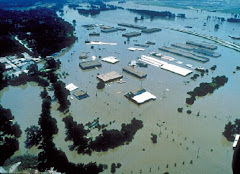It is important to understand the significance that global warming has on not only our earth, but our daily lives as well. It’s also important to understand the effects of global warming that our children and grandchildren will experience in the years to come if things continue the way they are now.
First, it’s important to understand that “Global Warming” is also known as the “Greenhouse effect”. Instead of a plastic or glass shield, the earth has around it a series of atmospheric gases consisting mostly of nitrogen and oxygen molecules. The earth is about 60 degrees Fahrenheit warmer than it would be if it didn’t have those atmospheric gases surrounding it. They keep the earth warm and protected from excess UV (Ultra Violet) rays from the sun. Once warmed, their molecules then radiate a portion of this heat energy back to earth, creating more warming on the surface of our planet. It is this radiation which causes atmospheric gases to move back to earth that scientists call the "greenhouse effect".
Much debate in the last five years about the greenhouse effect has centered on interpreting temperature numbers generated at weather stations all over the world. The data from these thermometers are averaged and plotted in attempts to determine just how fast the earth has heated up since the measurements began. There is now no doubt the world is getting warmer. The thermometers show that the world is warmer now than at any time since the measurements started. The year 1990 was the hottest year in the last century. Together with 1991, the years of 1983, 1987, 1988, and 1989, have been measured to be the warmest 6 years in the last hundred years. 1991 was the second warmest year of the past century, perhaps due to the eruption of Mt. Pinatubo during that year. The ash from the volcano in the upper atmosphere blocks some sunlight to earth, and is expected to generate a temporary two or three year cooling effect. After that time, most ash particles will have settled back to earth, and most scientists expect to see the global warming trend continue.
According to scientists, we can with "99% confidence conclude that current temperatures represent a real warming trend rather than a chance fluctuation over the 30-year period." Most scientists agree that the planet's temperature has risen 0.5 degrees Celsius since 1900, and will continue to increase at an increasing rate. The environment is responding to this warming. For instance, a study of mountain plants in the Alps (Europe), shows that some cold-loving plants are starting to move to higher and cooler altitudes. That is a possible response to increasing temperatures.
The global effects of the greenhouse effect cannot be directly predicted simply because we do not have enough knowledge in the subject. However, we have been able to draw direct connections between certain natural phenomenon that supports the idea that something is changing.
Global warming has great effect on crops and weather conditions around the world. The northern hemisphere contains more land area than the southern hemisphere, and conversely, a lower percentage of the world's oceans. Since oceans absorb more heat than land areas, it is not surprising that most climate models predict faster heating over the northern hemisphere than the global average. In addition, models predict faster temperature increases at higher latitudes. If global warming trends continue, high temperatures everywhere in the US may reduce US agricultural productivity.
Northern continental areas are projected to have drier summer soils, due in part to earlier snow melts in the spring, and hotter, more cloudless summers, causing extensive evaporation of ground moisture. In addition, if the inland areas of the northern hemisphere are expected to receive less moisture, then, lake and river levels will be lower. Some reports predict the level of the Great Lakes will drop between 2 and 8 feet. River flows in the western US may be very vulnerable to increase temperatures expected as result of the greenhouse effect.
Article Directory: http://www.articledashboard.com

